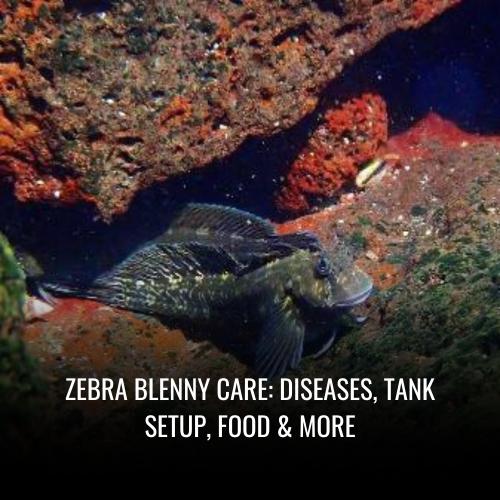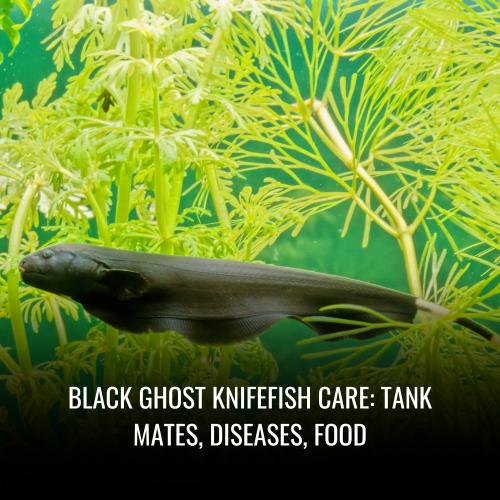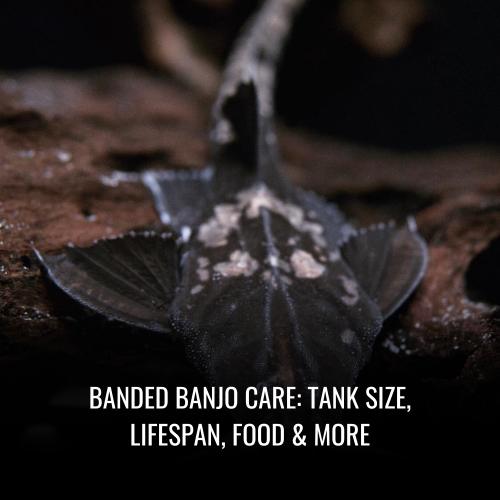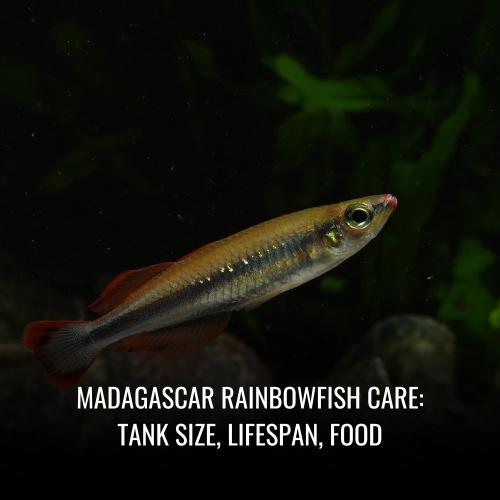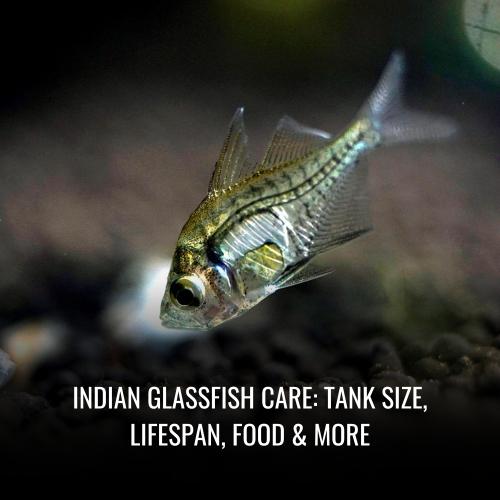Giant glassfish Care: tank mates, Diseases, Food
This post contains affiliate links. As an Amazon Associate, we earn from qualifying purchases.
One of the most striking features of the giant glassfish is its translucent body, which is a result of its unique biological composition. Unlike other fish, the giant glassfish has a skeletal structure and internal organs that are partially or entirely see-through, creating an otherworldly effect that captures the imagination of all who encounter it.
This remarkable adaptation is not only a visual spectacle but also serves as a form of camouflage, allowing the giant glassfish to blend seamlessly into its surroundings, making it a highly efficient predator in the ocean’s depths.
| Attribute | Description |
|---|---|
| Scientific name | Parambassis siamensis |
| Common name | Giant Glassfish |
| Family | Chandidae |
| Usual size in fish tanks | 3 – 4 inches (7.62 – 10.16 cm) |
| Recommended pH range | 6.5 – 7.5 |
| Recommended water hardness | 5 – 15 dGH |
| Recommended temperature | 75 – 82°F (24 – 28°C) |
| Reproduction | Egg layers, scatterers |
| Origin | Southeast Asia, including Thailand, Cambodia, Vietnam |
| Temperament to own species | Can be aggressive, especially during breeding |
| Temperament toward other fish | Peaceful, but can eat smaller tankmates |
| Usual place in the tank | Middle to top water column |
| Lifespan | 4 – 6 years |
| Tank size requirement | Minimum of 20 gallons |
| Filtration system | Can tolerate various filtration systems |
| Sexual dimorphism | Males are usually slimmer and more colorful |
| Substrate cleaning | Does not require specific substrate cleaning |
Scientific Name
The intriguing world of Aquatic glassfish is dominated by the genus Parambassis, a remarkable group known for their transparent bodies and peaceful nature. Among the 19 recognized species of this genus, the Parambassis gulliveri stands out as the true giant, earning it the common name Giant Glassfish.
Several notable species within the genus include the Parambassis pulcinella, or the Humphead glassy perchlet, distinguished by its distinctive nuchal hump. Additionally, the Indian glassy perchlet, known scientifically as Parambassis ranga, is a popular choice among aquarists. Other unique species, such as the High-finned glassy perchlet (Parambassis altipinnis) and the Iridescent glassy perchlet (Parambassis apogonoides), each bear their own scientific name, signaling the diversity found within this genus.
Aquarium enthusiasts are drawn to these species, not only for their intriguing translucence but also for the serenity they bring to the communal tank environment. When choosing a Parambassis for your aquarium, it’s vital to recognize each species by its scientific nomenclature:
- Giant Glassfish: Parambassis gulliveri
- Humphead glassy perchlet: Parambassis pulcinella
- Indian glassy perchlet: Parambassis ranga
- High-finned glassy perchlet: Parambassis altipinnis
- Iridescent glassy perchlet: Parambassis apogonoides
Understanding these scientific names is essential for any ichthyological survey or hobbyist research, ensuring the correct species is studied or introduced into the aquatic habitat.
Average Size
The Giant Glassfish, a captivating member of the Parambassis genus, showcases an impressive size for an Asiatic glassfish species. On average, these fish measure between 4 to 5 inches (10 to 13 centimeters) in length in a home aquarium setting. Aquarists might sometimes be surprised to find some individuals surpassing this range, reaching up to 6 inches (15 centimeters) when provided with optimum conditions.
| Age Group | Average Size |
|---|---|
| Juvenile | 1 inch (2.5 cm) |
| Adult | 4-5 inches (10-13 cm) |
| Exceptional Adults | Up to 6 inches (15 cm) |
The environment within the fish tank plays a pivotal role in their growth. Factors influencing the size include the diet — which ideally should include a variety of brine shrimp, river shrimp, and frozen foods — along with high water quality and an adequately spacious tank that meets their needs.
It’s interesting to note that within the species, mature female Giant glassfish usually grow slightly larger than their male counterparts. This phenomenon is particularly pronounced during the reproductive season when females are brimming with eggs, ready for spawning.
- Ideal Tank Conditions for Growth:
- Varied diet (incl. brine shrimp, frozen foods)
- High-quality water
- Sufficient tank space
Lifespan
When kept in an optimal aquarium environment, the Giant Glassfish, scientifically known as Parambassis ranga, can enjoy a longevity of approximately 5 to 6 years. Achieving this age bracket in captivity is quite feasible with rigorous attention to their care, including maintaining supreme water conditions and providing a balanced diet rich in key nutrients.
A stress-free living space is imperative for these fish to thrive and reach their potential lifespan. Several elements dictate the health and longevity of Giant Glassfish:
- Water Quality: Clean and well-filtered water is essential.
- Nutrition: A varied diet with items like brine shrimp and frozen foods aids in their well-being.
- Disease Prevention: Employing preemptive measures against common aquatic ailments ensures a healthier life.
In contrast to their captive life, wild Giant Glassfish often face a reduced lifespan due to natural predators and environmental difficulties. Therefore, the captive environment presents a safer haven that favors their long-term survival.
The diligent aquarist can create a hospitable tank setting that significantly aids in extending the life of these fascinating fish.
Natural Habitat
The Humphead Glassfish, recognized scientifically as Parambassis pulcinella, thrives in the clear and shallow waters of the Ataran River basin in Myanmar, with potential populations in similar areas in Thailand. These swift streams with fast currents provide an ideal environment for these fish, thanks to the abundance of rocks around which they navigate with finesse.
In these habitats, Humphead Glassfish exhibit sociable group behaviors, often seen in schools amongst the dynamic water flows. Their predatory nature surfaces as they hunt for food, capturing a variety of small aquatic animals. A presumed resilient diet is indicative of their adaptability to available resources, suggesting an opportunistic feeding pattern with a preference for:
- Small Fish
- River Shrimp
- Aquatic Insect Larvae
Understanding their natural habitat is crucial to replicate conditions in captivity and ensure their health and well-being.
Appearance
The Giant Glassfish, scientifically known as Parambassis pulcinella, offers an extraordinary spectacle for any aquarium enthusiast. Its most remarkable feature is a transparent body, a natural wonder that creatively displays the fish’s internal organs, captivating those who observe it. Adding to its unique aesthetic is the prominent nuchal hump on its head, separating it apart from other glassfish species.
Accentuating its allure, the blue iridescent edges that line the Giant Glassfish’s dorsal and anal fins flash a stunning visual display, entrancing onlookers with every graceful swish through the water. This species possesses a streamlined, elongated silhouette adorned with subtle dorsal spines that enhance its elegance without detracting from its overall sleek body shape.
In a spacious fish tank environment, the Giant Glassfish can reach an impressive size of up to 15 cm in length, making them a grand and majestic presence amidst the underwater landscape.
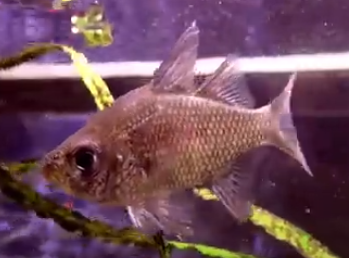
Behavior & Temperament
Amidst the diverse personalities in the aquatic world, the Giant glassfish, Parambassis pulcinella, exhibits an endearing peacefulness that aquarists cherish. They glide harmoniously through the tank, displaying their serene nature and making them iconic for community fish collections. Their non-aggressive demeanor makes them an excellent choice for those seeking tank mates that are both visually captivating and tranquilly coexistent.
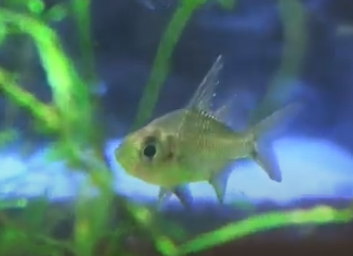
Are Giant glassfish Fin Nippers?
Giant glassfish are renowned for their gentle conduct and lack the troublesome trait of fin nipping. Their peaceful temperament is evident in the community tank, where they engage more with their environment than with the appendages of their tank mates. As such, fin nipping is an unlikely behavior for this species, making them a safe companion for a wide variety of other fish.
| Behavior | Temperament | Compatibility |
|---|---|---|
| Non-fin nipper | Peaceful | High |
Are Giant glassfish Aggressive To Each Other & Other Fish?
Not only are Giant glassfish placid amongst their own kind, but they also extend this peacefulness to their interspecies interactions. They seldom display aggression, and their existence in a multi-species community tank is often marked by cohabitation rather than conflict. Only during the excitement of breeding may they occasionally exert mild territoriality, but even then, actual aggressive encounters are rare.
Are Giant glassfish Friendly To Each Other & Other Fish?
Indeed, Giant glassfish are convivial aquatic playfellows. Their schooling nature in the wild translates beautifully to aquarium life, where they often form close-knit groups, swimming in unison and enhancing each other’s company. Compatible even with species dissimilar to themselves, these glassfish are seen as affable neighbors in the diverse community tank.
Are Giant glassfish Schooling Fish?
Absolutely, Giant glassfish thrive in the company of their own. When in a school, they exhibit exquisite aquatic ballets, showcasing their natural inclination to swim in harmony. The sight of a group articulating through the water column is both calming and socially fulfilling for these fish, making them an engaging spectacle for observers.
Can You Have Just One Giant glassfish In The Tank?
While it’s technically feasible to house a solitary Giant glassfish, it is far from ideal. Isolation can foster stress and timidity, detracting significantly from their intrinsic behavior and overall happiness. Homes with groups of six or more Giant glassfish will observe a more vibrant, active, and natural display from these peaceful creatures.
Do Giant glassfish Need To Be In Groups?
To encapsulate the essence of Giant glassfish behavior, they are indeed social creatures that find solace and security within a group. Living in a shoal not only bolsters their confidence but also catalyzes a display of dynamic social interactions. Thus, keeping them in groups is not just a recommendation—it is a critical element for their welfare and a key to unlocking their full spectrum of behaviors in captivity.
| Requirement | Group Size | Benefits |
|---|---|---|
| Social Cohabitation | 6+ | Reduces Stress, Encourages Natural Behavior |
Food & Diet
The dietary habits of Giant glassfish (Parambassis pulcinella) reflect their carnivorous nature and predatory inclinations in the wild. A combination of small fish, crustaceans, and aquatic insect larvae accounts for their core sustenance. In the contained world of an aquarium, their initial hesitance towards prepared foods often necessitates the simulation of live prey using frozen fare like brine shrimp and bloodworms. Over time, they adapt to a more diverse culinary selection, encompassing fresh, frozen, or dried aquarium diet staples.
| Preferred Prey in Wild | Aquarium Diet Options |
|---|---|
| Small fish | Earthworms, river shrimp, bloodworms, blackworms |
| Shrimps | Brine shrimp, river shrimp (frozen/live) |
| Aquatic insect larvae | Daphnia, tubifex, and occasional flake or pellet foods |
Quality flake food should serve as the cornerstone of their dietary regimen, supplemented two to three times weekly with nutrient-rich treats like bloodworm, brine shrimp, tubifex, and daphnia. Despite their predominant meaty food preferences, Giant glassfish also benefit from a balanced diet through the careful rotation of food types.
Do Giant glassfish Eat Algae?
Giant glassfish maintain a carnivorous diet, precluding algae as a major component of their nutrition. While they may sporadically sample algae in their habitat, these instances are minimal and do not contribute significantly to their diet. Aquarists should orient their feeding practices away from algae and towards animal-protein rich alternatives to support the glassfish’s well-being.
Do Giant glassfish Eat Shrimp?
Yes, shrimp constitute a prime food source for Giant glassfish. Their predatory instincts drive them to actively pursue small crustaceans, such as brine and river shrimp. Both live and frozen varieties of shrimp are eagerly consumed and make an essential contribution to their diet in an aquarium environment.
Do Giant glassfish Eat Bloodworms?
Bloodworms are not just accepted but relished by Giant glassfish as part of their omnivorous feeding repertoire. These aquatic creatures provide protein and other vital nutrients, enhancing the Giant glassfish’s health and vibrancy. Bloodworms can be served in frozen or live form, providing an exciting element of diversity to their daily nourishment.
Do Giant glassfish Eat Mosquito Larvae?
Giant glassfish are opportunistic feeders, and mosquito larvae naturally fall within their dietary preferences. This live food source is aligned with their instinctual feeding habits and is replete with the nutrients needed for their maintenance in the aquarium. The inclusion of mosquito larvae in their diet mirrors the richness of their wild cuisine and supports their health optimally.
Do Giant glassfish Eat Planaria?
Planaria, although not the most common aquarium food, can be a nutritious addition to the Giant glassfish’s diet. Given their opportunistic and predatory feeding behavior, Giant glassfish can certainly ingest planaria as a meaty snack, thus integrating it seamlessly into their food selection.
Do Giant glassfish Eat Plants?
Giant glassfish predominantly favor a protein-centric diet, primarily based on meaty foods, and show little interest in plant consumption. They are unlikely to seek out or eat plants actively, as their carnivorous needs are met by preying on live or frozen protein sources. Aquarists should prioritize a diet rich in animal proteins to fulfill the dietary needs of Giant glassfish.
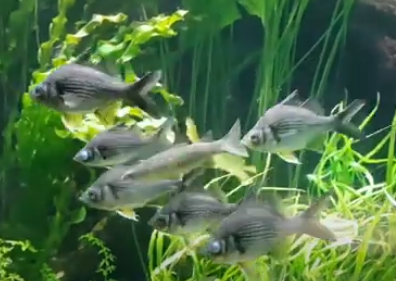
Sexing: Male vs Female
Determining the sex of Giant glassfish is straightforward due to distinct physical differences between males and females.
Identifying Male Giant Glassfish:
- Fins: Males boast a striking blue edge on their fins, a feature not found in females.
- Nuchal Hump: A notable hump on the forehead is present and more prominent in males, making them easily distinguishable.
Identifying Female Giant Glassfish:
- Fins: Female fins lack the distinctive blue coloring, remaining clear.
- Forehead: Females might display a hump as well, but it is less pronounced than in their male counterparts.
Gender Identification in Community Tanks: When observing a group, these markers offer reliable cues to sexing Giant glassfish:
| Gender | Fin Color | Nuchal Hump Size |
|---|---|---|
| Male | Blue edge | Prominent |
| Female | Clear | Small/Less distinct |
By taking note of these visual hints, breeders and aquarists can pair males with females effectively for reproduction. Close examination and comparison will reveal the subtle yet distinct variances between the sexes.
Giant glassfish Tank Mates
Giant glassfish are serene inhabitants of the aquarium, thriving in a tranquil community setting. Their nature makes them compatible with a variety of small community fish, particularly those that prefer the bustling middle levels of the tank. These Asiatic glassfish show a preference for sharing space with swift midwater swimmers, promoting a dynamic yet peaceful aquarium ecology.
When curating tank mates for Giant glassfish, it’s crucial to steer clear of overly assertive species to maintain a harmonious environment. Aggressive tank companions, such as larger cichlids, puffers, and certain sharks or loaches, should be avoided as they can disrupt the placidity of the Giant glassfish.
Additionally, Giant glassfish display an innate ability to evade the territories of dwarf cichlids like Microgeophagus ramirezi and Pelviachromis pulcher, thanks to their quick midwater movements. This trait allows them to coexist comfortably without intruding on the personal space of these bottom dwellers.
Ideal Tank Companions for Giant Glassfish:
- Peaceful small community fish
- Fast-swimming midwater species
Aquarists who covet a touch of uniqueness in their tanks are starting to recognize the charm of these larger species of glassfish, especially the smaller variants that harmoniously blend in with a diverse community aquarium.
Aquarium Setup
When it comes to creating a suitable home for Giant glassfish, it’s essential to focus on replicating their natural environment to the best of our abilities. The atmospheric rivers and streams of South Asia, where these fish originate, are marked by moderate currents, abundant vegetation, and subdued lighting—a setup that can be achieved in a home aquarium with attention to detail and proper equipment.
Ideal Tank Size
To ensure the well-being of Giant glassfish, a minimum tank size of 20 gallons is necessary for a small group. These active swimmers require ample space to express their natural behaviors, and the additional volume of water helps to keep water parameters stable. For larger groups, a 40-gallon or bigger aquarium is highly recommended, providing the necessary horizontal swimming space. A longer tank is particularly suitable for Giant glassfish due to their preference for the midwater column.
Ideal Water Parameters
Giant glassfish flourish in slightly acidic to neutral water conditions, with pH levels ranging from 6.5 to 7.5, which is typical of their South Asian river habitats. The water temperature is optimal between 72°F and 78°F (22°C to 26°C), creating a comfortable ambiance that these fish are accustomed to. Keep ammonia and nitrite levels at zero and maintain good water circulation to ensure a well-oxygenated environment for these sensitive species.
Filtration
High-quality filtration is non-negotiable for maintaining a healthy ecosystem for Giant glassfish. Integrating mechanical, biological, and chemical filtration within your aquarium setup will help manage the moderate bioload produced by these fish and sustain clear, pristine waters. Choose a filtration system that offers a gentle flow, akin to the steady streams of their native habitat, and remember that steady maintenance routines are vital for filtration efficacy.
Lighting
Mimic the dimly lit environments of the Giant glassfish’s natural settings by opting for low to moderate lighting in the aquarium. Incorporate floating plants or use tall flora to naturally diffuse the light, reducing the harshness. Adjustable LED fixtures are excellent choices, allowing for a controlled luminosity that won’t overwhelm your glassfish. Moreover, applying a timer to the lighting system can simulate a natural day-night cycle, providing comfort and regularity for your aquatic residents.
Common Possible Diseases & Prevention
Despite their resilience, Humphead Glassfish (Parambassis pulcinella) can still confront health issues typically found in tropical fish, including the common ailment ‘ich’. Ensuring their robustness requires a well-maintained tank environment and vigilance against introducing diseases.
Prevention:
- Quarantine: Always quarantine new fish, plants, or tank additions to prevent the spread of infections.
- Cleaning: Properly clean substrates and decorations before introducing them to your tank to eliminate potential pathogens.
- Natural Habitat: Mimic their natural habitat to reduce stress, as stress can lead to a compromised immune system.
- Balanced Diet: Offer a mix of brine shrimp, river shrimp, and frozen foods to keep the fish in good health.
Prompt action is vital in preventing a disease from affecting your entire tank:
Quick Tips:
- Isolate Affected Fish: Limit outbreaks by immediately quarantining any sick fish.
- Monitor Regularly: Keep a close eye on your fish’s behavior and appearance for early detection of issues.
- Maintain Water Quality: Regular water changes and maintaining appropriate oxygen levels are essential.
By following these preventative measures, you can maintain the vitality and health of your Humphead Glassfish community.
Breeding Giant glassfish In Aquarium
Breeding Giant Glassfish, such as Parambassis pulcinella, within the confines of an aquarium remains shrouded in mystery. To date, the intricacies of their reproductive behavior, including the spawning intricacies, mating rituals, and the subsequent care of their fry, are areas yet untapped in ichthyological research. Aquarium enthusiasts who wish to witness or assist in the propagation of Giant Glassfish are met with a dearth of information—no well-documented methods or proven techniques to facilitate breeding in captivity have been made available.
The lack of documented breeding successes for species such as the Humphead Glassfish (Parambassis ranga) indicates that specific conditions or triggers, critical for their reproduction, are still beyond our understanding. The absence of a blueprint means that even the fundamental aspects of breeding—courtship displays or parental care—are hidden from the purview of practical fishkeeping.
This gap in knowledge serves as a call to action for aquarists and researchers alike, emphasizing the need for an ichthyological survey to decode the life cycle of these elusive creatures. It is within these undocumented waters that opportunities for discovery lie, beckoning those dedicated to the cause of Progressive Fishkeeping to explore and enlighten.
| Breeding Aspect | Status |
|---|---|
| Documented Techniques | None established |
| Spawning Habits and Rituals | Not studied or recorded |
| Fry Rearing Practices | Undocumented |
| Aquarium Breeding Successes | No successful accounts reported |
| Requirement for Breeding Triggers | Unknown; further research needed |
As such, for those captivated by the enigma of Asiatic glassfish, patience and pioneering spirit remain essential tools in unraveling the secrets of breeding Giant Glassfish in aquarium settings.
Are Giant glassfish Easy To Keep?
Giant glassfish, captivating in their translucent beauty, are generally considered manageable for dedicated aquarists. Once acclimated and feeding consistently on a diet of live or frozen foods, such as brine shrimp and river shrimp, these peaceful fish can thrive in the aquarium setting. However, deprivation of such nutritious offerings can predispose them to weakened conditions and an increased risk of diseases, highlighting the significance of a balanced diet.
In terms of disease susceptibility, Giant glassfish do not typically fall ill with ease. They are fairly resilient and respond positively to treatment when faced with common ailments such as white spot disease. Implementing the use of commercial treatments proves effective, and the selective introduction of slightly brackish water can be a preventive strategy against fungal infections.
Compatibility with other fish is rarely an issue; Giant glassfish are non-aggressive and integrate well into the serene dynamics of community tanks. Small, peaceful species are recommended as tank mates to maintain an amicable environment. However, care should be taken when keeping multiple Giant glassfish together, as they may exhibit aggressive behaviors toward one another if not housed in sufficient numbers. A stable group can diminish the chances of such aggression, allowing them to demonstrate their natural schooling behavior.
Giant glassfish, with their preference for a calm habitat and absence of inherent territorial aggression, stand out as laudable candidates for community aquariums. Their gentle nature and intriguing appearance are increasingly recognized and cherished among fishkeeping enthusiasts.
| Factor | Consideration for Giant Glassfish Care |
|---|---|
| Dietary Needs | Regular live or frozen foods are crucial for health and vitality. |
| Disease Management | Responsive to treatments; brackish water may prevent infections. |
| Behavior and Compatibility | Non-aggressive; best in groups to avoid intra-species conflict. |
| Aquarium Setting | Ideal for peaceful community tanks; unique and non-predatory. |
Are Giant glassfish Sensitive To Water Changes?
Although Giant glassfish are not overly sensitive to routine fluctuations in aquarium conditions, stability is key to their well-being. Extreme and abrupt variances in temperature, pH, and hardness can cause undue stress. These aquatic beings rely on a stable environment to remain in optimal health.
When it’s time for a water change, caution must be exercised to avoid shocking the delicate systems of Giant glassfish. Matching the temperature, pH, and hardness of the new water to the parameters of the existing aquarium is essential. Steadiness in water quality not only reassures these fish but helps maintain their immune defenses.
To facilitate their comfort, significant adjustments to their aquatic home should be incremental, allowing them the necessary time to adjust. Regular monitoring of the habitat, coupled with prudent acclimation of new water, safeguards against undue stress and promotes the longevity and happiness of Giant glassfish.
Are Giant glassfish Sensitive To Ammonia?
Vigilance in water quality is a must, especially regarding ammonia levels, as Giant glassfish showcase a particular sensitivity to this toxic compound. Ammonia’s presence in higher concentrations can lead to gill damage, impairing respiration and sparking respiratory distress.
Are Giant glassfish Sensitive To Copper?
Special attention must be given to copper, a substance to which Giant glassfish have a distinct intolerance. In the confines of an aquarium, the presence of copper can inflict gill damage, disrupt necessary ions, and result in listlessness. Tap water can be a source of this metal and, thus, should be treated cautiously when introduced into their environment.
The use of copper test kits can assist in maintaining copper at safe levels for the welfare of the glassfish. Furthermore, copper-free water conditioners and strict adherence to medication dosages become critical in safeguarding Giant glassfish from the adverse effects of copper toxicity.

